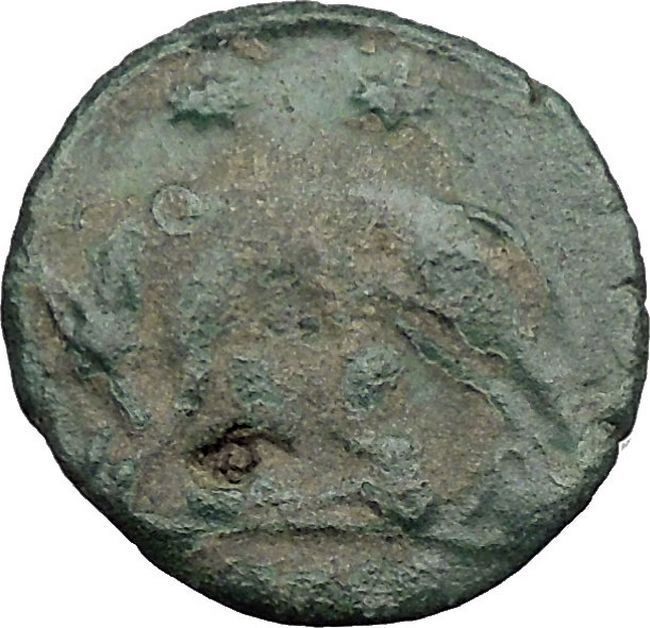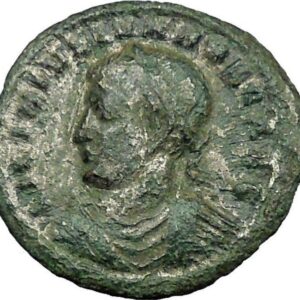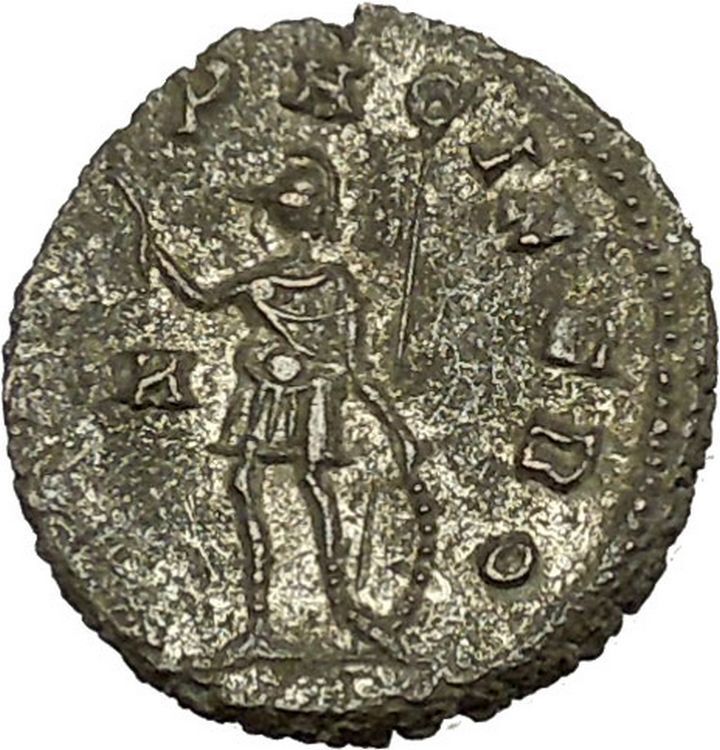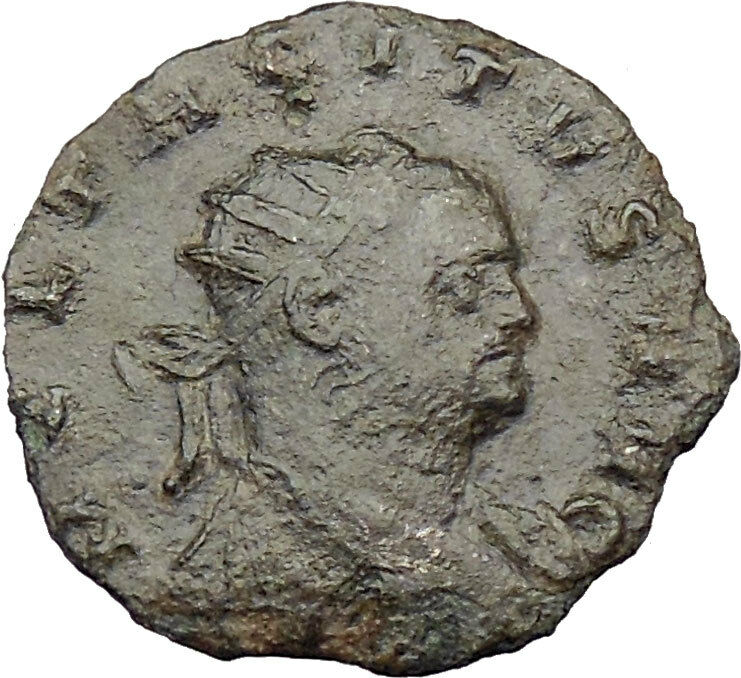|
Aurelian –
Roman Emperor
: 270-275 A.D. –
Bronze Antoninianus 20mm (2.88 grams) Struck circa 272-274 A.D.
IMPAVRELIANVSAVG – Radiate, cuirassed bust right.
IOVICONSER – Aurelian standing right on left, receiving globe from Jupiter
to right,
holding scepter.
Royal/Imperial symbols of power
Ruling dynasties often exploit pomp and ceremony with the use of
regalia
:
crowns
,
robes,
orb (globe) and sceptres
, some of which are
reflections of formerly practical objects. The use of language mechanisms also
support this differentiation with subjects talking of “the crown” and/or of “the
throne
” rather than referring directly to
personal names and items.
You are bidding on the exact item pictured,
provided with a Certificate of Authenticity and Lifetime Guarantee of
Authenticity.

In
ancient Roman religion
and
myth
, Jupiter (Latin:
Iuppiter) or Jove is the
king of the gods
and the
god of sky
and
thunder
. Jupiter was the chief deity of Roman
state religion throughout the
Republican
and
Imperial
eras, until the Empire
came under Christian rule
. In
Roman mythology
, he negotiates with
Numa Pompilius
, the second
king of Rome
, to establish principles of Roman
religion such as sacrifice.
Jupiter is usually thought to have originated as a sky god. His identifying
implement is the
thunderbolt
, and his primary sacred animal is
the eagle, which held precedence over other birds in the taking of
auspices
and became one of the most common
symbols of the
Roman army
(see
Aquila
). The two emblems were often combined to
represent the god in the form of an eagle holding in its claws a thunderbolt,
frequently seen on Greek and Roman coins. As the sky-god, he was a divine
witness to oaths, the sacred trust on which justice and good government depend.
Many of his functions were focused on the
Capitoline
(“Capitol Hill”), where the
citadel
was located. He was the chief deity of
the
early Capitoline Triad
with
Mars
and
Quirinus
. In the
later Capitoline Triad
, he was the central
guardian of the state with
Juno
and
Minerva
. His sacred tree was the oak.
The Romans regarded Jupiter as the
equivalent
of Greek
Zeus, and in
Latin literature
and
Roman art
, the myths and iconography of Zeus
are adapted under the name Iuppiter. In the Greek-influenced tradition,
Jupiter was the brother of
Neptune
and
Pluto
. Each presided over one of the three
realms of the universe: sky, the waters, and the underworld. The
Italic
Diespiter was also a sky god who
manifested himself in the daylight, usually but not always identified with
Jupiter. The
Etruscan
counterpart was
Tinia
and
Hindu
counterpart is
Indra
.
Relation to other gods
Archaic Triad
The Archaic Triad is a theological structure (or system) consisting of the
gods Jupiter, Mars and Quirinus. It was first described by Wissowa, and the
concept was developed further by Dumézil. The three-function hypothesis of
Indo-European society
advanced by Dumézil holds
that in prehistory, society was divided into three classes (priests, warriors
and craftsmen) which had as their religious counterparts the divine figures of
the sovereign god, the warrior god and the civil god. The sovereign function
(embodied by Jupiter) entailed omnipotence; thence, a domain extended over every
aspect of nature and life. The colour relating to the sovereign function is
white.
The three functions are interrelated with one another, overlapping to some
extent; the sovereign function, although essentially religious in nature, is
involved in many ways in areas pertaining to the other two. Therefore, Jupiter
is the “magic player” in the founding of the Roman state and the fields of war,
agricultural plenty, human fertility and welth.
Capitoline Triad
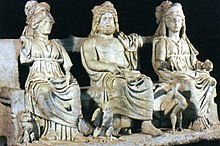
Capitoline Triad
The Capitoline Triad was introduced to Rome by the Tarquins. Dumézil thinks
it might have been an Etruscan (or local) creation based on Vitruvius’ treatise
on architecture, in which the three deities are associated as the most
important. It is possible that the Etruscans paid particular attention to
Menrva
(Minerva) as a goddess of destiny, in
addition to the royal couple Uni (Juno) and Tinia (Jupiter).[169]
In Rome, Minerva later assumed a military aspect under the influence of
Athena Pallas
(Polias). Dumézil argues that
with the advent of the Republic, Jupiter became the only king of Rome, no longer
merely the first of the great gods.
Jupiter and Minerva
Apart from being protectress of the arts and craft as Minerva Capta, who was
brought from Falerii, Minerva’s association to Jupiter and relevance to Roman
state religion is mainly linked to the
Palladium
, a wooden statue of Athena that could
move the eyes and wave the spear. It was stored in the penus interior,
inner penus of the aedes Vestae, temple of Vesta and considered the most
important among the
pignora imperii
, pawns of dominion, empire.[170]
In Roman traditional lore it was brought from Troy by Aeneas. Scholars though
think it was last taken to Rome in the third or second century BC.
Juno and Fortuna
The divine couple received from Greece its matrimonial implications, thence
bestowing on Juno the role of tutelary goddess of marriage (Iuno Pronuba).
The couple itself though cannot be reduced to a Greek apport. The association
of Juno and Jupiter is of the most ancient Latin theology.
Praeneste
offers a glimpse into original Latin
mythology: the local goddess
Fortuna
is represented as milking two infants,
one male and one female, namely Jove (Jupiter) and Juno. It seems fairly safe to
assume that from the earliest times they were identified by their own proper
names and since they got them they were never changed through the course of
history: they were called Jupiter and Juno. These gods were the most ancient
deities of every Latin town. Praeneste preserved divine filiation and infancy as
the sovereign god and his paredra Juno have a mother who is the primordial
goddess Fortuna Primigenia.[174]
Many terracotta statuettes have been discovered which represent a woman with a
child: one of them represents exactly the scene described by Cicero of a woman
with two children of different sex who touch her breast. Two of the votive
inscriptions to Fortuna associate her and Jupiter: ” Fortunae Iovi puero…” and
“Fortunae Iovis puero…”
In 1882 though R. Mowat published an inscription in which Fortuna is called
daughter of Jupiter, raising new questions and opening new perspectives
in the theology of Latin gods. Dumezil has elaborated an interpretative theory
according to which this aporia would be an intrinsic, fundamental feature
of Indoeuropean deities of the primordial and sovereign level, as it finds a
parallel in Vedic religion. The contradiction would put Fortuna both at the
origin of time and into its ensuing diachronic process: it is the comparison
offered by Vedic deity
Aditi
, the Not-Bound or Enemy of
Bondage, that shows that there is no question of choosing one of the two
apparent options: as the mother of the
Aditya
she has the same type of relationship
with one of his sons,
Dakṣa
, the minor sovereign. who represents the
Creative Energy, being at the same time his mother and daughter, as is
true for the whole group of sovereign gods to which she belongs. Moreover Aditi
is thus one of the heirs (along with
Savitr
) of the opening god of the Indoiranians,
as she is represented with her head on her two sides, with the two faces looking
opposite directions. The mother of the sovereign gods has thence two solidal but
distinct modalities of duplicity, i.e. of having two foreheads and a double
position in the genealogy. Angelo Brelich has interpreted this theology as the
basic opposition between the primordial absence of order (chaos) and the
organisation of the cosmos.
Janus
The relation of Jupiter to Janus is problematic. Varro defines Jupiter as the
god who has potestas (power) over the forces by which anything happens in
the world. Janus, however, has the privilege of being invoked first in rites,
since in his power are the beginnings of things (prima), the appearance
of Jupiter included.
Saturn
The
Latins
considered Saturn the predecessor of
Jupiter. Saturn reigned in
Latium
during a mythical
Golden Age
reenacted every year at the festival
of Saturnalia
. Saturn also retained primacy in
matters of agriculture and money. Unlike the Greek tradition of
Cronus
and Zeus, the usurpation of Saturn as
king of the gods by Jupiter was not viewed by the Latins as violent or hostile;
Saturn continued to be revered in his temple at the foot of the Capitol Hill,
which maintained the alternative name Saturnius into the time of Varro.[182]
A. Pasqualini has argued that Saturn was related to Iuppiter Latiaris,
the old Jupiter of the Latins, as the original figure of this Jupiter was
superseded on the Alban Mount, whereas it preserved its gruesome character in
the ceremony held at the sanctuary of the Latiar Hill in Rome which involved a
human sacrifice and the aspersion of the statue of the god with the blood of the
victim.
Fides
The abstract
personification
Fides (“Faith, Trust”) was one
of the oldest gods associated with Jupiter. As guarantor of public faith, Fides
had her temple on the Capitol (near that of Capitoline Jupiter).
Genius
Augustine quotes Varro who explains the genius as “the god who is in
charge and has the power to generate everything” and “the rational spirit of all
(therefore, everyone has their own)”. Augustine concludes that Jupiter should be
considered the genius of the universe.
G. Wissowa advanced the hypothesis that Semo
Sancus
is the genius of Jupiter.[189]
W. W. Fowler has cautioned that this interpretation looks to be an anachronism
and it would only be acceptable to say that Sancus is a Genius Iovius, as
it appears from the Iguvine Tables.
Censorinus cites
Granius Flaccus
as saying that “the Genius was
the same entity as the Lar” in his lost work De Indigitamentis. Dumézil
opines that the attribution of a Genius to the gods should be earlier than its
first attestation of 58 BC, in an inscription which mentions the Iovis Genius.
A connection between Genius and Jupiter would be apparent in
Plautus
‘ comedy
Amphitryon
, in which Jupiter takes up the
looks of Alcmena
‘s husband in order to seduce her: J.
Hubeaux sees there a reflection of the story that
Scipio Africanus
‘ mother conceived him with a
snake that was in fact Jupiter transformed. Scipio himself claimed that only he
would rise to the mansion of the gods through the widest gate.
It is noteworthy that among the Etruscan Penates there is a Genius
Iovialis who comes after Fortuna and Ceres and before Pales . Genius
Iovialis is one of the earthly Penates and not one of the Penates of
Jupiter though, as these were located in region I of Martianus Capella’ s
division of Heaven, while Genius appear in regions V and VI along with Ceres,
Favor (possibly a Roman approximation to an Etruscan male manifestation of
Fortuna) and Pales.
Victoria

Coin with
laureate
head of Jupiter (obverse)
and (reverse) Victory, standing (“ROMA” below in
relief
)
Victoria was connected to Iuppiter Victor in his role as bestower of
military victory. Jupiter, as a sovereign god, was considered as having the
power to conquer anyone and anything in a supernatural way; his contribution to
military victory was different from that of
Mars
(god of military valour). Victoria appears
first on the reverse of coins representing Venus (driving the quadriga of
Jupiter, with her head crowned and with a palm in her hand) during the first
Punic War. Sometimes, she is represented walking and carrying a trophy.
A temple was dedicated to the goddess afterwards on the Palatine, testifying
to her high station in the Roman mind. When
Hieron of Syracuse
presented a golden statuette
of the goddess to Rome, the Senate had it placed in the temple of Capitoline
Jupiter among the greatest (and most sacred) deities. Although Victoria played a
significant role in the religious ideology of the late Republic and the Empire,
she is undocumented in earlier times. A function similar to hers may have been
played by the little-known
Vica Pota
.
Lucius Domitius Aurelianus
(September
9, 214
or 215 –September or October 275), known in English as
Aurelian,
Roman
Emperorr
(270–275), was the second of several highly successful
“soldier-emperors” who helped the
Roman
Empire
regain its power during the latter part of the third century and the
beginning of the fourth.
During his reign, the Empire was reunited in its
entirety, following fifteen years of rebellion, the loss of two-thirds of its
territory to break-away empires (the
Palmyrene Empire
in the east and the
Gallic Empire
in the west) and devastating barbarian invasions. His
successes started the end of the empire’s
Crisis of the Third Century
.
//
Aurelian was an upwardly-mobile soldier who was eventually appointed
commander of the cavalry by Claudius II. With the aid of a sympathetic army he
revolted against the accession of Quintillus and a civil war was avoided when
the latter committed suicide following the growing popularity of his rival.
Aurelian was then hailed as emperor by the Senate and the rest of the legions
alike. His first mission was to strengthen the army by the introduction of the
strictest reforms and discipline as well as quelling the various uprisings that
had broken out over the last two decades. He thus spent the next five years
until cut down by his own Praetorian Guard at the height of his glory. It seems
Aurelian’s personal secretary, after being reprimanded by the emperor for
attempted extortion, felt an execution would follow. To guard against this
possibility, he concocted a story about Aurelian intending to execute his
personal guard and then rushed to share with them this manufactured evidence.
Naturally, afraid for their lives, they entered the emperor’s quarters and
effected a preemptive strike. Somehow or other it was soon afterward found out
that the formerly beloved emperor had no such motives and his secretary himself
was swiftly executed for treason. When news reached Rome of what had happened
Aurelian’s wife seems to have actually been left nominally in power while a new
emperor was selected, a period that may have lasted several months. Although
history is a little hazy in this matter, it would mark the first and only time a
Roman empress explicitly ruled the empire.
Rise to power
Aurelian was born in
Dacia ripensis
or
Sirmium
(now
Sremska Mitrovica
,
Serbia
),
to an obscure provincial family; his father was tenant to a senator named
Aurelius, who gave his name to the family.
Aurelian served as a general in several wars, and his success ultimately made
him the right-hand man and dux equitum (cavalry commander) of the army of
Emperor Gallienus
. In 268, his cavalry routed the powerful cavalry force of the
Goths
at the
Battle of Naissus
and broke the back of the most fearsome invasion of Roman
territory since Hannibal
. According to one source, Aurelian participated in the
assassination of Gallienus (268), and supported
Claudius II
for the purple.
Two years later, when Claudius died his brother
Quintillus
seized power with support of the Senate. With an act typical of the
Crisis of the Third Century
, the army refused to recognize the new emperor,
preferring to support one of its own commanders: Aurelian was proclaimed emperor
in September 270 by the
legions
in Sirmium. Aurelian defeated Quintillus’ troops, and was recognized emperor by
the Senate after Quintillus’ death. The claim that Aurelian was chosen by
Claudius on his death bed
can be dismissed as propaganda; later, probably in 272, Aurelian put his own
dies imperii the day of Claudius’ death, thus implicitly considering
Quintillus a
usurper
.
With his base of power secure, he now turned his attention to Rome’s greatest
problems — recovering the vast territories lost over the previous two decades,
and reforming the res publica.
Conqueror and reformer
In 248, Emperor
Philipp
had celebrated the millennium of the city of Rome with great and
expensive ceremonies and games, and the empire had given a tremendous proof of
self-confidence. In the following years, however, the empire had to face a huge
pressure from external enemies, while, at the same time, dangerous civil wars
threatened the empire from within, with a large number of usurpers weakening the
strength of the state. Also the economical substrate of the state, the
agriculture and the commerce, suffered from the disruption caused by the
instability. On top of this an epidemic swept through the Empire around 250,
greatly diminishing manpower both for the army and for agriculture. The end
result was that the empire could not endure the blow of the capture of Emperor
Valerian
in 260: the eastern provinces found their protectors in the rulers
of the city of Palmyra
, in
Syria
Palmyrene Empire
, a separate entity from the Roman Empire, successful
against the Persian threat; the western provinces, those facing the
limes
of the
Rhine
seceded,
forming a third, autonomous state within the territories of the Roman Empire,
which is now known as
Gallic Empire
; the emperor, in Rome, was occupied with the internal menaces
to his power and with the defence of
Italia
and the Balkans. This was the situation faced by Gallienus and
Claudius, and the problems Aurelian had to deal with at the beginning of his
rule.
Reunification of the empire
The first actions of the new emperor were aimed at strengthening his own
position in his territories. Late in 270, Aurelian campaigned in northern
Italia
against the
Vandals
,
Juthungi
,
and Sarmatians
, expelling them from Roman territory. To celebrate these
victories, Aurelian was granted the title of Germanicus Maximus.
The authority of the emperor was challenged by several
usurpers
—
Septimius
,
Urbanus
,
Domitianus
, and the rebellion of
Felicissimus
— who tried to exploit the sense of insecurity of the empire
and the overwhelming influence of the armies in Roman politics. Aurelian, being
an experienced commander, was aware of the importance of the army, and his
propaganda, known through his coinage, shows he wanted the support of the
legions.
Defeat of the Alamanni
The burden of the northern barbarians was not yet over, however. In 271, the
Alamanni
moved towards Italia, entering the Po plain and sacking the villages; they
passed the
Po River
, occupied
Placentia
and moved towards Fano
.
Aurelian, who was in Pannonia to control
Vandals
‘
withdrawal, quickly entered Italia, but his army was defeated in an
ambush near Placentia
(January 271). When the news of the defeat arrived in
Rome, it caused great fear for the arrival of the barbarians. But Aurelian
attacked the Alamanni camping near the
Metaurus River
,
defeating them in the
Battle of Fano
, and forcing them to re-cross the Po river; Aurelian finally
routed them at
Pavia
. For this, he received the title Germanicus Maximus. However,
the menace of the German people remained high as perceived by the Romans, so
Aurelian resolved to build the walls that became known as the
Aurelian Walls
around
Rome.
The emperor led his legions to the Balkans, where he defeated and routed the
Goths beyond the Danube, killing the Gothic leader
Cannabaudes
, and assuming the title of Gothicus Maximus. However, he
decided to abandon the province of
Dacia
,
on the exposed north bank of the Danube, as too difficult and expensive to
defend. He reorganised a new province of Dacia south of the Danube, inside the
former Moesia
,
called Dacia Ripensis, with
Serdica
as the capital.
Conquest of the Palmyrene Empire
In 272, Aurelian turned his attention to the lost eastern provinces of the
empire, the so-called “Palmyrene
Empire” ruled by Queen
Zenobia
from
the city of Palmyra
.
Zenobia had carved out her own empire, encompassing
Syria
, Palestine
, Egypt
and large parts of
Asia Minor
. In the beginning, Aurelian had been recognized as emperor, while
Vaballathus
, the son of Zenobia, hold the title of rex and
imperator (“king” and “supreme military commander”), but Aurelian decided to
invade the eastern provinces as soon as he felt strong enough.
Asia Minor was recovered easily; every city but
Byzantium
Tyana
surrendered to him with little resistance. The fall of Tyana lent itself to a
legend; Aurelian to that point had destroyed every city that resisted him, but
he spared Tyana after having a vision of the great 1st century philosopher
Apollonius of Tyana
, whom he respected greatly, in a dream. Apollonius
implored him, stating: “Aurelian, if you desire to rule, abstain from the blood
of the innocent! Aurelian, if you will conquer, be merciful!” Whatever the
reason, Aurelian spared Tyana. It paid off; many more cities submitted to him
upon seeing that the emperor would not exact revenge upon them. Within six
months, his armies stood at the gates of Palmyra, which surrendered when Zenobia
tried to flee to the
Sassanid Empire
. The “Palmyrene Empire” was no more. Eventually Zenobia and
her son were captured and forced to walk on the streets of Rome in his triumph.
After a brief clash with the Persians and another in Egypt against usurper
Firmus
, he was
forced to return to Palmyra in 273 when that city rebelled once more. This time,
Aurelian allowed his soldiers to sack the city, and Palmyra never recovered from
this. More honors came his way; he was now known as Parthicus Maximus and
Restitutor Orientis (“Restorer of the East”).
Conquest of the Gallic Empire
In 274, the victorious emperor turned his attention to the west, and the “Gallic
EmpireeTetricus
was willing to abandon his throne and allow Gaul and Britain to return to the
empire, but could not openly submit to Aurelian. Instead, the two seem to have
conspired so that when the armies met at
Châlons-en-Champagne
that autumn, Tetricus simply deserted to the Roman camp
and Aurelian easily defeated the Gallic army facing him. Tetricus was rewarded
for his part in the conspiracy with a high-ranking position in Italy itself.
Aurelian returned to Rome and won his last honorific from the Senate —
Restitutor Orbis (“Restorer of the World”). In four years, he had secured
the frontiers of the empire and reunified it, effectively giving the empire a
new lease on life that lasted 200 years.
Reformations
Aurelian was a reformer, and settled many important functions of the imperial
apparatus, including the economy and the religion. He also restored many public
buildings, re-organized the management of the food reserves, set fixed prices
for the most important goods, and prosecuted misconduct by the public officers.
Religious reform
Aurelian strengthened the position of the Sun god,
Sol
(invictus)
or Oriens, as the main divinity of the Roman pantheon. His intention was to give
to all the peoples of the Empire, civilian or soldiers, easterners or
westerners, a single god they could believe in without betraying their own gods.
The center of the cult was a new temple, built in 271 in
Campus Agrippae
in Rome, with great decorations financed by the spoils
of the Palmyrene Empire. Aurelian did not persecute other religions. However,
during his short rule, he seemed to follow the principle of “one god, one
empire”, that was later adopted to a full extent by
Constantine
. On some coins, he appears with the title deus et dominus
natus (“God and born ruler”), also later adopted by Diocletian.
Lactantius
argued that Aurelian would have outlawed all the other gods if he had had enough
time.
Felicissimus’ rebellion and coinage reform
Aurelian’s reign records the only uprising of mint workers. The
rationalis
Felicissimus
, mintmaster at Rome, revolted against Aurelian. The revolt
seems to have been caused by the fact that the mint workers, and Felicissimus
first, were accustomed to stealing the silver used for the coins and producing
coins of inferior quality. Aurelian wanted to erase this practice, and put
Felicissimus under trial. The rationalis incited the mintworkers to
revolt: the rebellion spread in the streets, even if it seems that Felicissimus
was killed immediately, possibly executed. The Palmirene rebellion in Egypt had
probably reduced the
grain supply to Rome
, thus disaffecting the population with respect to the
emperor. This rebellion also had the support of some senators, probably those
who had supported the election of
Quintillus
,
and thus had something to fear from Aurelian. Aurelian ordered the urban
cohorts, reinforced by some regular troops of the imperial army, to attack the
rebelling mob: the resulting battle, fought on the
Caelian hill
, marked the end of the revolt,
even if at a high price (some sources give the figure, probably exaggerated, of
7,000 casualties). Many of the rebels were executed; also some of the rebelling
senators were put to death. The mint of Rome was closed temporarily, and the
institution of several other mints caused the main mint of the empire to lose
its hegemony.
antoninianii
containing 5% silver. They bore the mark XXI
(or its Greek numerals form KA), which meant that twenty of such
coins would contain the same silver quantity of an old silver
denarius
.
Considering that this was an improvement over the previous situation gives an
idea of the severity of the economic situation Aurelian faced. The emperor
struggled to introduce the new “good” coin by recalling all the old “bad” coins
prior to their introduction.
Death
In 275, Aurelian marched towards Asia Minor, preparing another campaign
against the Sassanids: the deaths of Kings
Shapur I
(272) and Hormizd I
(273) in quick succession, and the rise to power of a weakened
ruler (Bahram I),
set the possibility to attack the Sassanid Empire.
On his way, the emperor suppressed a revolt in Gaul — possibly against
Faustinus, an officer or usurper of Tetricus — and defeated barbarian marauders
at Vindelicia
(Germany).
However, Aurelian never reached Persia, as he was murdered while waiting in
Thrace to cross into Asia Minor. As an administrator, Aurelian had been very
strict and handed out severe punishments to corrupt officials or soldiers. A
secretary of Aurelian (called Eros by y
Zosimus
) had
told a lie on a minor issue. In fear of what the emperor might do, he forged a
document listing the names of high officials marked by the emperor for
execution, and showed it to collaborators. The notarius Mucapor and other
high-ranking officiers of the
Praetorian Guard
, fearing punishment from the Emperor, murdered him in
September of 275, in Caenophrurium
, Thrace (modern Turkey).
Aurelian’s enemies in the Senate briefly succeeded in passing
damnatio memoriae
on the emperor, but this was reversed before the end
of the year and Aurelian, like his predecessor Claudius II, was deified as
Divus Aurelianus.
Ulpia Severina, wife of Aurelian and
Augusta
since 274, is said to have held the imperial role during the
short interregnum before the election of
Marcus Claudius Tacitus
to the purple.
|








